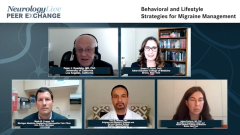
Unmet Needs in the Management of Migraine
Episodes in this series

Differentiating between episodic, chronic, and acute migraine and discussion of unmet needs in traditional acutely acting therapies for migraine.
Peter J. Goadsby, MD, PhD: Hello, and welcome to this Neurology Live® Peer Exchange® titled, “Advances in the Management of Acute Treatment of Migraine.” I’m Dr Peter Goadsby from the University of California, Los Angeles Goldberg Migraine Program in Los Angeles, California.
Joining me today for the virtual discussion are my colleagues Dawn Buse from the Albert Einstein College of Medicine in the Bronx, New York; Wade Cooper from Michigan Medicine Headache & Neuropathic Pain Clinic in Ann Arbor, Michigan; Dr Paul Mathew, from the Brigham and Women’s Hospital and Harvard Medical School in Boston, Massachusetts; and Dr Jelena Pavlovic from the Montefiore Headache Center and Albert Einstein College of Medicine in the Bronx, New York. Today we’re going to discuss a number of topics pertaining to the diagnosis and treatment of acute migraine. Let’s get started on our first topic.
We’re going to talk about unmet needs. I’m going to ask Dawn Buse to take us through a bit of the current state of thinking around the prevalence and disease burden of migraine in the United States.
Dawn C. Buse, PhD: Thank you, Dr Goadsby, and hello to our virtual audience. We’re speaking to neurologists. This is no surprise. You know that migraine is quite prevalent. In fact, the World Health Organization reminded us recently that there are over a billion people, about 1.04 billion, who live with migraine around the world. In the United States, we have at least 12% of adults, including up to 18% of women and about 6% of men—a 3:1 female-to-male ratio—at any given time living with migraine.
You know this because this is 1 of the most common reasons for visits to a neurologist. You’re going to see plenty of migraine in your practice. We know that migraine is most common in midlife. It may start in childhood. It often starts in teens or young adulthood and stays most frequent, severe, and disabling through the 30s, 40s, and 50s. It then tends to become less frequent and less disabling but not always. That’s the broad snapshot of migraine in the world, in the United States, and in your practice.
Peter J. Goadsby, MD, PhD: Thanks, Dawn. People often talk about the underdiagnosis and undertreatment of migraine, particularly in the context of episodic and chronic migraine. I’ll ask you, Paul, to comment about that differentiation between episodic and chronic migraine and comment a bit on undertreatment.
Paul G. Mathew, MD: Sure. Episodic and chronic refer to how many headache days per month someone is having. Episodic migraine [EM] is defined as fewer than 15 headache days per month, while chronic migraine [CM] is 15 or more headache days per month. That may seem like an arbitrary number. It’s just divided by the number of days per month, which is 30. But there is some significance to it. As you’re having more frequent migraine, such as with chronic migraine, there is a bit of a difference in terms of the pathophysiology and likelihood of progression of migraine.
A simpler way of saying it is, the more frequently you’re having migraine, the more frequently you’re going to have migraine moving forward, from a statistical standpoint. In addition, the 2 labels are important because certain therapies like botulinum toxin injections are FDA approved for chronic migraine and not for episodic. As time goes by, we see that a lot of the treatments for migraine don’t make that differentiation. A lot of the newer treatments, which we’ll be talking about today, are applicable for both episodic and chronic migraine.
The other term that is sometimes floated around is acute migraine. That’s not a reference to the frequency of migraine or headache days per month. Rather, acute migraine refers to medications that are used to treat individual attacks. In terms of diagnosis, it is still striking to me that about 44% of people with headache disorders are actually diagnosed, leaving 56% of people undiagnosed.
Obviously, if you never make the diagnosis, then you’re never able to get proper treatment for your headache disorder, which is really problematic and leads to many people suffering unduly. Many of our patients in this country find that they can’t treat their headaches properly because they assume that over-the-counter treatments are all that’s available. In fact, there is a growing armamentarium of both abortive and preventive treatments available.
The other thing I’ll say is that among the people who are not diagnosed, which is that 56% number, 24% of them are seeking headache care and never receive a diagnosis, even though 1 of their complaints is headache. Raising awareness in both clinicians and the public is tremendously important so that more people are diagnosed and more people are able to get the care they need.
Peter J. Goadsby, MD, PhD: Paul made a very good point around the 15 days, which is that it does seem arbitrary. It was arbitrary, actually. It was an arbitrary decision made by the Headache Classification Committee of the International Headache Society. If you look at a population, when does the number start to get bothersome? Fifteen is just a line in the sand. When should you get concerned and get thinking?
Dawn C. Buse, PhD: Dr Goadsby, you were part of the Headache Classification Committee, which made some of those important decisions.
Peter J. Goadsby, MD, PhD: Or mistakes.
Dawn C. Buse, PhD: No. We continue to do epidemiological research and clinic-based research to see where things change. A very high percentage of neurologists live with migraine. Sixty percent of headache expert neurologists have migraine. Another 20% have a family member with migraine. A lot of us are personally familiar with the burden and the experience. You might say the number at which the impact increases is much lower than about every other day.
If we think back to about 4 headache days per month—about 1 day of your life per week lost—we start to see dramatic reductions in socioeconomic status and quality of life, increases in depression and anxiety, and burden on the family. That is not only the person with migraine, but burden increases on their children and their partners or spouses. We’ve seen this in CaMEO, or Chronic Migraine Epidemiology and Outcomes, study data. We also see it in an AMPP [American Migraine Prevalence and Prevention] study in which we looked at a couple different groups in the EM group—0 to 3, 4 to 7, and 8 to 14 days per month.
In 1 of the studies, we also divided the CM group, because having headache every other day might be quite different from having daily or nonstop migraine. We see that with each of these increases, there are dramatic increases in comorbidities, reduction in quality of life, increases in disability, and financial and costly wellness burdens on people living with migraine. We see that stepping as low as 4 days per month, and I say low with the caveat that someone losing a whole day every week of their life is nothing to be taken lightly.
Peter J. Goadsby, MD, PhD: It makes the point that clinicians need to be thinking about burden in proportion to how the patient feels it, rather than some number that would drive it. If it weren’t for the legal things, as Paul said, maybe the 15-day thing would be less important.
Dawn C. Buse, PhD: We did see some changes in more recent clinical trials. There were also some changes with the approvals for the newer preventive classes. Fewer than 15 days a month are being required. In fact, the newer preventive class didn’t have any day requirement. It was more about clinician judgment on the level of disability impact or possibly a patient benefiting from prevention.
Peter J. Goadsby, MD, PhD: Of course, we’ve been handing out old-style routine preventives—propranolol, topiramate, amitriptyline—at much lower frequencies than 15 days per month for at least as long as I’ve been practicing
Jelena Pavlovic, MD, PhD: We’ve been recommending it at 4 or more headache days per month, right? That has been the recommendation, but it’s also what the patient needs. All of us have had patients who have 10 headache days a month and are reluctant to go on preventatives, particularly women of reproductive age. That is where migraine seems to fall and live primarily, and is particularly burdensome. The wonderful studies Dawn has conducted with Richard Lipton in AMPP show the gender difference. Migraine is particularly burdensome in women.
The second problem when we’re talking about underdiagnosis is that migraine is more frequently underdiagnosed or misdiagnosed in women. We know that when women seek help for headache that’s frequent and bothersome, they’re less likely than men to get the correct diagnosis, further complicating this very significant issue.
Newsletter
Keep your finger on the pulse of neurology—subscribe to NeurologyLive for expert interviews, new data, and breakthrough treatment updates.







































